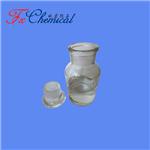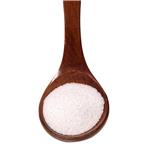Description
(-)-alpha terpineol is the alpha form of terpineol, a naturally monoterpene alcohol that can be isolated from various kinds of sources such as cajuput oil, pine oil, and petitgrain oil. The alpha form is the major constituent of terpineol. It is a common component in perfumes, cosmetic and flavors. It is also a kind of solvent used for extracting natural spices and as a kind of solvent of acetate fibers. Moreover, it exhibited strong and broad antimicrobial activity against fungi, bacteria and virus. Study has demonstrated that is antibacterial (bactericidal) effect originated from its destroying effect on the cell wall and cell membrane of bacteria. It also has certain anticonvulsant activity.
References
de Sousa, Damiao Pergentino, Lucindo Quintans Jr, and Reinaldo Nóbrega de Almeida. "Evolution of the anticonvulsant activity of α-terpineol."Pharmaceutical Biology 45.1 (2007): 69-70.
Park, Soon-Nang, et al. "Antimicrobial effect of linalool and α- terpineol against periodontopathic and cariogenic bacteria." Anaerobe 18.3 (2012): 369-372.
Dabbah, Roger, V. M. Edwards, and W. A. Moats. "Antimicrobial action of some citrus fruit oils on selected food-borne bacteria." Applied microbiology19.1 (1970): 27-31.
Chemical Properties
α-Terpineol is a kind of clear colorless liquid after melting, which has a characteristic lilac odor with a sweet taste reminiscent of peach on dilution.
Properties and Applications
α-Terpineol is a colorless,
crystalline solid, smelling of lilac. The most important commercial grade of
terpineol consists of a liquid mixture of isomers that contains mainly α-terpineol
and a considerable amount of ?γ-terpineol. This mixture has a stronger lilac odor
than does pure crystalline α-terpineol.
Hydrogenation of α-terpineol yields p-menthan-8-ol. Terpineol is readily dehydrated
by acids, yielding a mixture of unsaturated cyclic terpene hydrocarbons.
Under mildly acidic conditions, terpin hydrate is formed. The most important reaction for the fragrance industry is esterification, particularly acetylation to terpinyl
acetate.
Terpineol with its typical lilac odor is one of the most frequently used fragrance
substances. It is stable and inexpensive and is used in soaps and cosmetics.
Occurrence
Reported found in more than 150 derivatives from leaves, herbs and flowers; the d-, l- and dl-isomers are known: the d-form is found in the essential oils from Cupressaceae in general; also in the oils of Elettaria cardamomum, star anise, marjoram, clary sage, neroli and others. The l-form is found in Satureia montana, lavandin, cajeput, lime, lemon, cinnamon leaves and the distillates from Pinaceae (with exception of Pinus silvestris, which contains d-terpineol together with racemic form); likewise, Nectandra elaiophora (wood) and petitgrain bigarade. The racemic form is found in cajenne linalool, Thymus caespititius, cajeput, Eucalyptus globulus; mixed with the l-form it is found in petitgrain; a nondefined form of terpineol has been reported in the bitter orange. Reported found in over 260 natural sources including apple, apple juice, apricot, sweet and sour cherry, citrus peel oils and juices, orange, lemon, etc.
Uses
A naturally-occuring monoterpene alcohol.Alpha-terpineol is used as an antioxidant, antiseptic, antihypernociception and anti-inflammatory. It is also used as a solvent. It is an important ingredient of pine oil disinfectants. Further, it is used as a fragrance in perfumes, fat denaturant for soap production and synthetic flavoring agent.
Preparation
Although α-terpineol occurs in many essential oils, only small
quantities are isolated, for example, by fractional distillation of pine oils.
A common industrial method of α-terpineol synthesis consists of the hydration
of α-pinene or turpentine oil with aqueous mineral acids to give crystalline
cis-terpin hydrate (mp 117 °C), followed by partial dehydration to α-terpineol.
Suitable catalysts are weak acids or acid-activated silica gel.
Selective conversion of pinene, 3-carene, and limonene or dipentene to terpineol,
without terpin hydrate formation is also used. Addition of organic acids (weak
acids require catalytic amounts of mineral acids) produces terpinyl esters, which
are subsequently hydrolyzed to terpineol, sometimes in situ.
Definition
ChEBI: A terpineol that is propan-2-ol substituted by a 4-methylcyclohex-3-en-1-yl group at position 2.
Aroma threshold values
Detection: 280 to 350 ppb. Aroma characteristics in 1% ethanol: pine-like, woody and resinous with a slight cooling lemon and lime citrus nuance, and a floral dry out.
Taste threshold values
Taste characteristics at 2 to 25 ppm: woody, terpy, lemon and lemon–lime-like with a slight herbal and floral nuance. Taste characteristics at 10 to 25 ppm: citrus woody with a lemon and lime nuance. It has a slight soapy mouthfeel.
General Description
α-Terpineol is a monoterpene alcohol. It is one of the components responsible for the antifungal activity of
Melaleuca alternifolia (tea tree) essential oil. The reaction rate constant of α-terpineol with OH radical and ozone was found to be (1.9±0.5)×10
-10cm
3 molecule
-1s
-1 and (3.0±0.2)×10
-16cm
3 molecule
-1s
-1, respectively.
Flammability and Explosibility
Non flammable
Synthesis
Obtained from terpin hydrate by splitting off water; from pentane tricarboxylic acid by cyclization, followed by esterification to the hydroxy ester, then the unsaturated ester and Grignard to terpineol; also from isoprene and methyl vinyl ketone, using methyl magnesium iodide.




